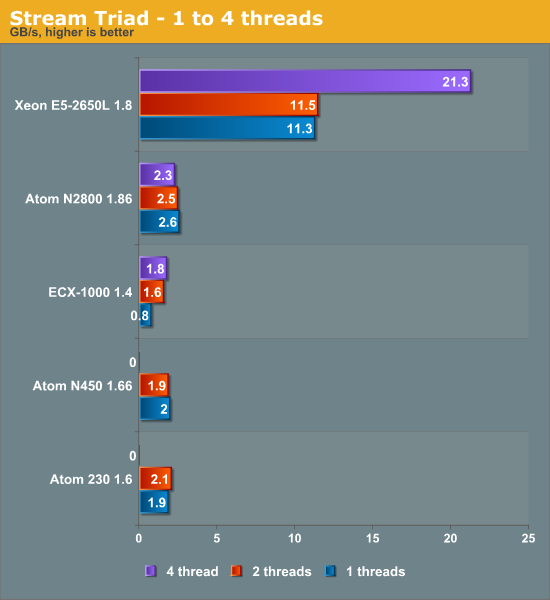Calxeda's ARM server tested
by Johan De Gelas on March 12, 2013 7:14 PM EST- Posted in
- IT Computing
- Arm
- Xeon
- Boston
- Calxeda
- server
- Enterprise CPUs
Measuring Bandwidth
Stream measures "sustainable memory bandwidth" and is thus a good indication of how a CPU will handle data intensive applications. Dr. John McCalpin is the developer and maintainer of the STREAM benchmark.
We compiled with gcc 4.7 on all platforms and used the -O3 -fopen -static settings. It is important to remark that this version of gcc has been optimized by the Linaro group, a non-profit software engineering effort. Linaro's objective is to optimize the kernel and typical tools for the ARM-Cortex A-series CPUs.
On the Intel CPUs we force the threads to make use of Hyper-Threading with taskset. So for example, the four threads measurement is done on two physical cores with four threads. This gives an idea of how a quad-core ARM server node compares to a virtual machine that gets a few physical and few logical cores from the hypervisor. It also allows us to evaluate how two threads on top of an Atom core compare to two ARM cores. When you compare CPUs with similar power consumption, you typically get two ARM cores for each Hyper-Threaded Atom core.

The ARM based server is a pretty bad choice right now for memory intensive workloads. Even with four cores and DDR3-1333, the useable bandwidth is less than one sixth of what one Xeon core can sustain.
In a similar vein, the ECX-1000 is not capable of providing more bandwidth than an Atom system equipped with DDR2-667. However, both the Atom and ARM cores are pretty bad when it comes to bandwidth. Although the specs claim that the CPUs can drive one channel of DDR3-1066, the measured bandwidth comes nowhere near the theoretical 8.5GB/s that such a DIMM can deliver.










99 Comments
View All Comments
kfreund - Friday, March 15, 2013 - link
Keep in mind that this is VERY early in the life cycle, and therefore costs are artificially high due to low volumes. Ramp up the volumes, and the prices will come WAY down.wsw1982 - Wednesday, April 3, 2013 - link
Ja, IF they have high volume. But even if there is high volume, it's shared between different ARM suppliers and needless to say, the ATOM. How much can it be for one company?But the question is where the ARM get the volume? less performance, comparable power consumption, less performance/watt rational (not this kind extreme bias case ), less flexibility, less software support (stability), vendor specific (you can build a normal server, but can you build up a massive parallel cluster?), oh, don't forgot, more (much more) expensive. Which company will sacrifice themselves to beef up the market volume of the ARM server?
Sputnik_b - Thursday, March 14, 2013 - link
Hi Johan,Nice job benchmarking and analyzing the results. Our group at EPFL has recently done some work aimed at understanding the demands that scale-out workloads, such as web serving, place on processor architectures. Our findings very much agree with your benchmark conclusions for the Xeon/Calxeda pair. However, a key result of our work was that many-core processors (with dozens of simple cores per chip) are the sweet spot with regard to performance per TCO dollar. I encourage you to take a look at our work -- http://parsa.epfl.ch/~grot/pubs/SOP-TCO_IEEEMicro....
Please consider benchmarking a Tilera system to round-out your evaluation.
Best regards!
Sputnik_b - Thursday, March 14, 2013 - link
Sorry, bad URL in the post above. This should work: http://parsa.epfl.ch/~grot/pubs/SOP-TCO_IEEEMicro....aryonoco - Friday, March 15, 2013 - link
LWN.net has a very interesting write-up on a talk given by Facebook's Director of Capacity Engineering & Analysis on the future of ARM servers and how they see ARM servers fit in with their operation. I think it gives valuable insight on this topic.http://lwn.net/SubscriberLink/542518/bb5d5d3498359... (free link)
phoenix_rizzen - Friday, March 15, 2013 - link
ARM already has hardware virtualisation extensions. Linux-KVM has already been ported over to support it.Andys - Saturday, March 16, 2013 - link
Great article, finally good to see some realistic benchmarks run on the new ARM platform.But I feel that you screwed up in one regard: You should have tested the top Xoen CPU also - the E5-2690.
As you know from your own previous articles, Intel's top CPUs are also the most power efficient under full load, and the price would still be cheaper than the full loaded Calxeda box anyway.
an3000 - Monday, March 25, 2013 - link
It is a test using wrong software stack. Yes, I am not afraid to say that! Apache will never be used on such ARM servers. They are exact match for Memcached or Nginx or another set-get type services, like static data serving. Using Apache or LAMP stack is too much favorable for Xeon.What I would like to see is: Xeon server with max RAM non-virtualized running 4-8 (similar to core count) instances of Memcached/Nginx/lighttpd vs cluster of ARM cores doing the same light task. Measure performance and power usage.
wsw1982 - Wednesday, April 3, 2013 - link
My suggestion will be let them run one hard-disk to one hard-disk copy and measure the power usage:)